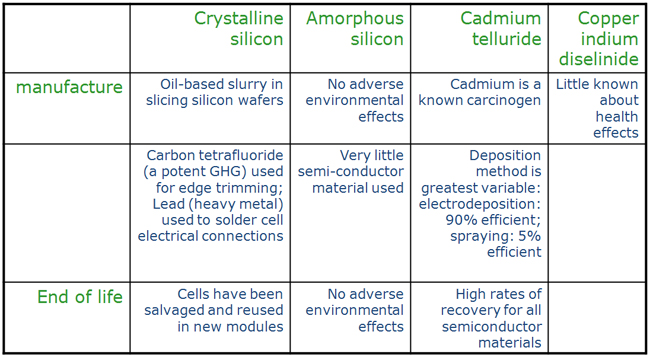#3 - USE RENEWABLE ENERGY
Renewable Energy should be used to provide all of the energy required by the project that cannot be met by both passive means (reduction) and the use of efficient and effective mechanical, electrical and plumbing equipment. Renewables can be provided "on site" on a building project basis as well as at a community level, which may make some strategies more economical and effective due to the change in scale. In some areas it may be possible to make a contract with a Green Energy Provider that ensures the cleanliness of the power source. Some regions, such as the State of California, are moving to mandate that a significant portion of the regular provider be devoted to renewable sources.
The on site renewables most often used in carbon neutral projects would be photovoltaics (both stand alone and BIPV), solar hot water heating, solar thermal, wind and geoexchange systems.
In the case of carbon neutrality, the definition of renewables must limit the scope of possibilities to exclude renewable sources whose energy is gained via combustion. So although systems such as Combined Heat and Power (CHP) may run on waste wood products, and wood is a renewable resource, CO2 is released through the combustion of the fuel. This is true of the use of most biomass based fuels. Some of these fuels may also release other greenhouse gases as well as a range of other pollutants that will vary depending upon the source of the material. There are arguments to be made for and against the general burning of wood products. If the wood is sourced on site and replanted at a pace to match its use, there are arguments that say that the growing wood is sequestering an "equal" amount of CO2 to that amount being generated by the burning of the fuel.
For the purposes of this project, and given the architectural focus of the solutions thus far, the use of systems that do not involve combustion will be preferred and discussed in more depth.
It is advised where possible to use more than one renewable energy source for a project. Given that solar and wind energy rely on sources that are not constant, using both systems assists in ensuring a constant supply of energy to the functions of the project.
The project also prefers Net Metering to the use of on site battery storage for excess power production. Batteries have durability issues and also significant embodied energy and toxicity associated with their manufacture and eventual disposal at end-of-life. However, Net Metering does bring about significant questions as to the source (cleanliness) of the electricity that might be drawn from the grid when there is a shorfall of available site energy. In order to certify a project as Carbon Neutral, this grid energy must be powered by clean sources.
THE ENVIRONMENTAL IMPACT OF RENEWABLES:
It is acknowledged that many of the solar and wind systems have associated environmental impacts as a result of their embodied energy, transportation of the products to site, and manufacturing processes. These environmental issues need to be weighed into a comprehensive study for the selection of materials that is also based upon their relative efficiencies, proximity for shipping and budgetary concerns.

Environmental Issues of Photovoltaics by Type of Silicon Used
For more information on renewable energy in the United States, visit the web site for the National Renewable Energy Laboratories (NREL).

HELPFUL LINKS IN THE AIA 50to50 WIKI:
Active Solar Thermal Systems
Co-Generation (CHP)
Energy Source Ramifications
Geoexchange
Photovoltaics
Renewable Energy
|

